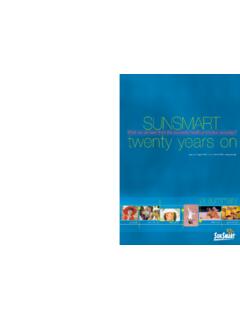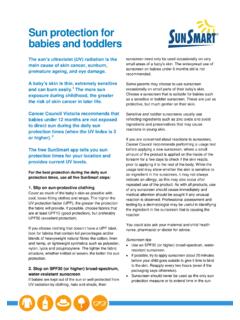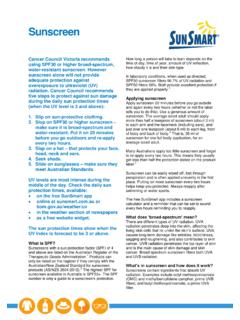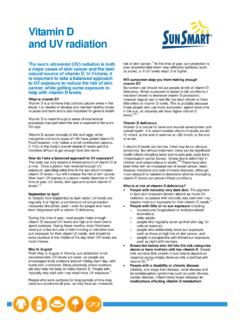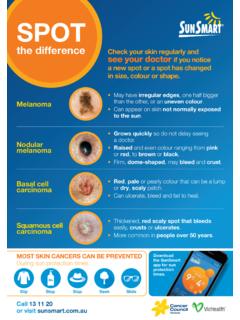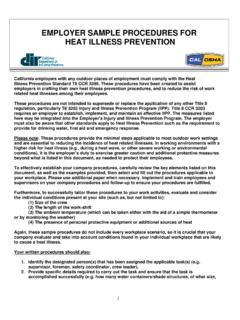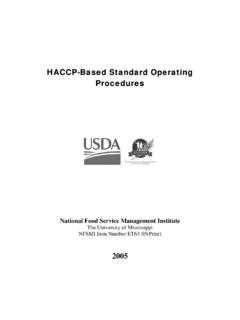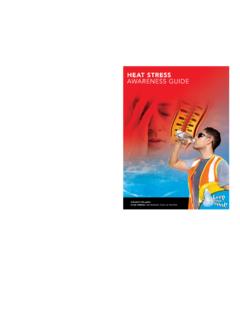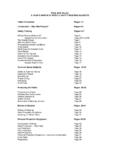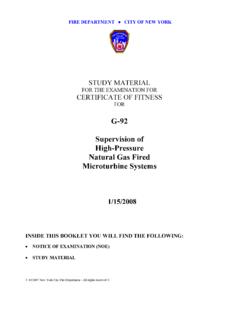Transcription of Skin cancer and outdoor work - SunSmart
1 skin cancer and outdoor workA guide for employersSkin cancer and outdoor work : A Guide for EmployersFirst published January 2007 Updated April 2012 cancer Council Victoria ISBN: 0 947283 90 0 Special acknowledgement to Karyn Knight, cancer Council Victoria together with contributions from the other state and territory cancer Councils. Developed on behalf of the National skin cancer Council Helpline 13 11 2 Purpose of this resource 2 The case for sun protection at work 3 The harmful health effects of ultraviolet radiation 3 skin cancer : the facts 4 skin cancer : an occupational disease priority area 5 Legal obligations 5 Facts about ultraviolet radiation 7 Factors affecting levels of UVR 8 Describing levels of UVR 9 The SunSmart UV Alert 10 Photosensitivity 10 UVR and glass 11 UVR and heat 12 Heat illness 12 Protecting your workers 13 Risk assessment 14 Sun protection measures 14 Engineering controls 14 Administrative controls 16 Personal protective equipment and clothing 16 Sun protective work clothing 16 Sun protective hats 17 Sunglasses 18 Sunscreen 18 Training workers to work safely in the sun 20A workplace sun protection policy 21 Monitoring program effectiveness 21 Health surveillance and skin cancer 23
2 Recommendations for workplaces 23 Key early detection messages for workers 24 Workplace medical checks and skin cancer 24A sample sun protection policy for workplaces 27 Further information and contacts 29 References 30 Explanation of terms and abbreviations 31 IntroductionWorkers who spend all or part of the day working outdoors are at risk of skin cancer . This is because solar radiation is carcinogenic to skin types can be damaged by exposure to ultraviolet radiation (UVR). Damage is permanent and irreversible and increases with each exposure. Under Australian occupational health and safety legislation, employers should be considering steps to reduce this risk and protect workers from ongoing exposure to UVR that can lead to skin cancer . Implementing a comprehensive sun protection program, which includes a range of simple protective measures, can prevent sun-related injuries and reduce the suffering and costs associated with skin cancer including reduced productivity, morale and financial especially at risk due to the outdoor nature of the work include.
3 Building and construction workers telecommunications and utilities workers swimming pool and beach lifeguards police and traffic officers agricultural, farming and horticultural workers landscape and gardening workers fisheries workers road workers municipal employees postal workers dockyard, port and harbour workers catering workers outdoor events workers physical education teachers and outdoor sports coaches surveyors forestry and logging workers ski instructors and lift operators mining and earth resources workers taxi, bus and truck drivers and delivery and courier services labour hire company of this resourceThis booklet explores the relationship between exposure to UVR and skin cancer . It provides you with information and advice to understand and confidently address sun protection in the workplace.
4 A comprehensive sun protection program is described, including various sun protection control measures presented as per the hierarchy of occupational hazard controls. Tips for success are included, along with a sample policy to assist with the development and implementation of your case for sun protection at workThe case for sun protection at workAustralia has one of the highest levels of skin cancer in the world2. Despite being an almost entirely preventable disease, at least two in every three Australians will develop skin cancer before they reach the age of amount of exposure required to cause skin cancer varies greatly from one person to another. However, in most people the risk of skin cancer increases with increasing amounts of exposure to the workplace is a major source of exposure for many adult Australians with outdoor workers receiving between five and ten times more sun exposure than indoor workers4.
5 It is not surprising that outdoor workers who are required to spend long periods of time working in the sun, year after year, have a higher than average risk of skin harmful health effects of ultraviolet radiationExposure to ultraviolet radiation (UVR) is known to cause adverse health effects on the skin , eyes and immune system. SunburnSunburn is a radiation burn to the skin . In Australia, sunburn can occur in as little as 11 minutes on a fine January day5. All types of sunburn, whether serious or mild, can cause permanent and irreversible skin damage. Mild sunburn that reddens and inflames the skin is known as first-degree sunburn. Second-degree sunburn occurs with more serious reddening of the skin and water blisters. Third-degree sunburn requires medical keratoses and premature ageing of the skin Solar keratoses are red, flattish, dry, scaling areas on the skin , sometimes called sunspots.
6 Sunspots are a warning sign that a person is prone to skin damage and skin visible signs of ageing are the result of damage to the skin caused by exposure to UVR6. This can include skin wrinkling, loss of elasticity, irregular pigmentation and altered skin Under occupational safety and health laws, employers have a duty of care to provide systems of work , information, training and personal protective clothing and equipment so employees are not exposed to hazards. Employees also have a duty of care to themselves and others in the workplace, and must comply with instructions and use the protective clothing and equipment provided. - WorkSafe WA Commissioner Lex McColluch (2011)Eye damageAcute effects of exposure to UVR on the eye include photokeratitis (inflammation of the cornea and the iris) and photoconjunctivitis (inflammation of the conjunctiva, the membrane that lines the inside of the eyelids and white of the eye), more commonly known as snow blindness or welder s flash.
7 Symptoms range from mild irritation to severe is evidence that chronic exposure to UVR contributes to age-related macular degeneration and cataracts, both a cause of blindness. Long-term effects may also include pterygium (white or creamy opaque growth on the cornea), squamous cell carcinoma of the conjunctiva and cancer on the skin surrounding the cancer : the facts The most serious health effect of exposure to UVR is skin cancer . Our body is made up of tiny building blocks called cells. Cells normally grow, divide, die and are replaced in a controlled way. cancer is a disease that occurs when the cells of the body are damaged, causing them to grow out of control. The skin is the largest organ of the body. skin cancer can grow when the cells that make up our skin are damaged.
8 In most cases this damage is caused by overexposure to top layer of the skin contains three different types of cells: basal cells, squamous cells and melanocytes. skin cancer types are named after the type of skin cell in which the cancer three types of skin cancer are:1. Basal cell carcinoma (BCC) is the most common type of skin cancer . It grows slowly over months and years and may damage nearby tissues and organs if left Squamous cell carcinoma (SCC) is less common but grows faster. It may spread to other parts of the body if left Melanoma is the least common but most dangerous type of skin cancer . Most skin cancer deaths are from melanoma. It is often fast growing and can spread to other parts of the body where it can form a new cell carcinomas and squamous cell carcinomas are often grouped together and called non-melanoma or common skin you know?
9 For a range of information on working safely in the sun, and support for workplaces and managers, visit your state or territory cancer can also access the free SunSmart UV Alert widget from and add it to their website homepage. The widget shows the daily weather, temperature and UV level specific to the site s location including details about the times sun protection is required each case for sun protection at workSkin cancer : an occupational disease priority areaSkin cancer can be an employment-related disease resulting from repeated and long-term exposure to a known carcinogen. skin cancer therefore fits within the national health and safety priority action area of preventing occupational disease more 2011 report on Workers compensation claims paid in Australia 2000-2009, Occupational exposure to ultraviolet (UV)
10 Radiation by cancer Council Western Australia showed Safe work Australia data indicating that a total of 1360 workers compensation claims for sun related injury/disease were made between 2000 and 2009, at a total cost of $ is suggested that given the long latency period associated with exposure and the onset of skin cancer , it is also likely that compensation claims greatly understate the real incidence of occupational skin obligations Occupational health and safety legislation, specific to each Australian state or territory, has the clear objective of preventing illness and injury at work and saving lives. All employers must protect workers by providing a safe working environment that is free of health risks. This includes taking proper steps to reduce the known health risks associated with exposure to UVR for workers who spend all or part of their time working also have a duty to take care of their own health and safety and cooperate with employers efforts to improve health and safety.


